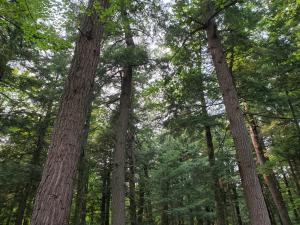Conservation, Restoration and Stormwater Seed Mixes
BWSR Resource Conservation Section staff have been working on updated state seed mixes (last updated in 2009). This includes the update of about 30 standard mixes and about 40 pilot mixes as well as new fact sheets for each mix and guidance on species substitutions and methods to adjust mixes for site conditions. Staff will also be collaborating with NRCS to ensure that mixes are working with NRCS Practices Standards when appropriate. A growing list of stakeholders helps guide this effort. If you are interested in getting involved, please contact Tara.Perriello@state.mn.us.
BWSR Vegetation Guidelines and Policy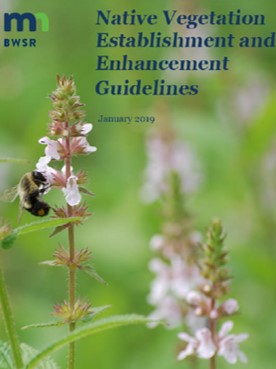
BWSR’s Native Vegetation Establishment and Enhancement Guidelines that provides vegetation policies for BWSR-funded projects were updated in 2019 with new guidance related to climate change, use of temporary covers and invasive species policies. In 2021, we updated information about guidance for specific project types, climate mitigation and adaptation, forestry practices and the use of perennial vegetation in agricultural systems. Contact Dan Shaw (dan.shaw@state.mn.us) to submit comments and suggestions related to these guidelines.
Habitat Friendly Solar Program
 BWSR’s Habitat Friendly Solar Program continues to evolve with rapid solar expansion in Minnesota. Updated assessment forms are now available for the planning stage of projects and for established projects. New sample plan specifications have also been developed. Some counties have started requiring that solar projects meet Habitat Friendly Solar standards (see Stearns County article as well as their webpage for solar projects) and we will be seeking opportunities for further discussion about solar projects, site inspection needs, addressing long-term management and program funding moving ahead. The first Habitat Friendly Solar Summit was held in February 2020 (over 80 people attended the event, which was held pre-COVID-19).
BWSR’s Habitat Friendly Solar Program continues to evolve with rapid solar expansion in Minnesota. Updated assessment forms are now available for the planning stage of projects and for established projects. New sample plan specifications have also been developed. Some counties have started requiring that solar projects meet Habitat Friendly Solar standards (see Stearns County article as well as their webpage for solar projects) and we will be seeking opportunities for further discussion about solar projects, site inspection needs, addressing long-term management and program funding moving ahead. The first Habitat Friendly Solar Summit was held in February 2020 (over 80 people attended the event, which was held pre-COVID-19).
A new yearly monitoring form has been added to the webpage under “resources” as well as updated sample project specifications and links to Local Government Solar Toolkits developed by the Great Plains Institute.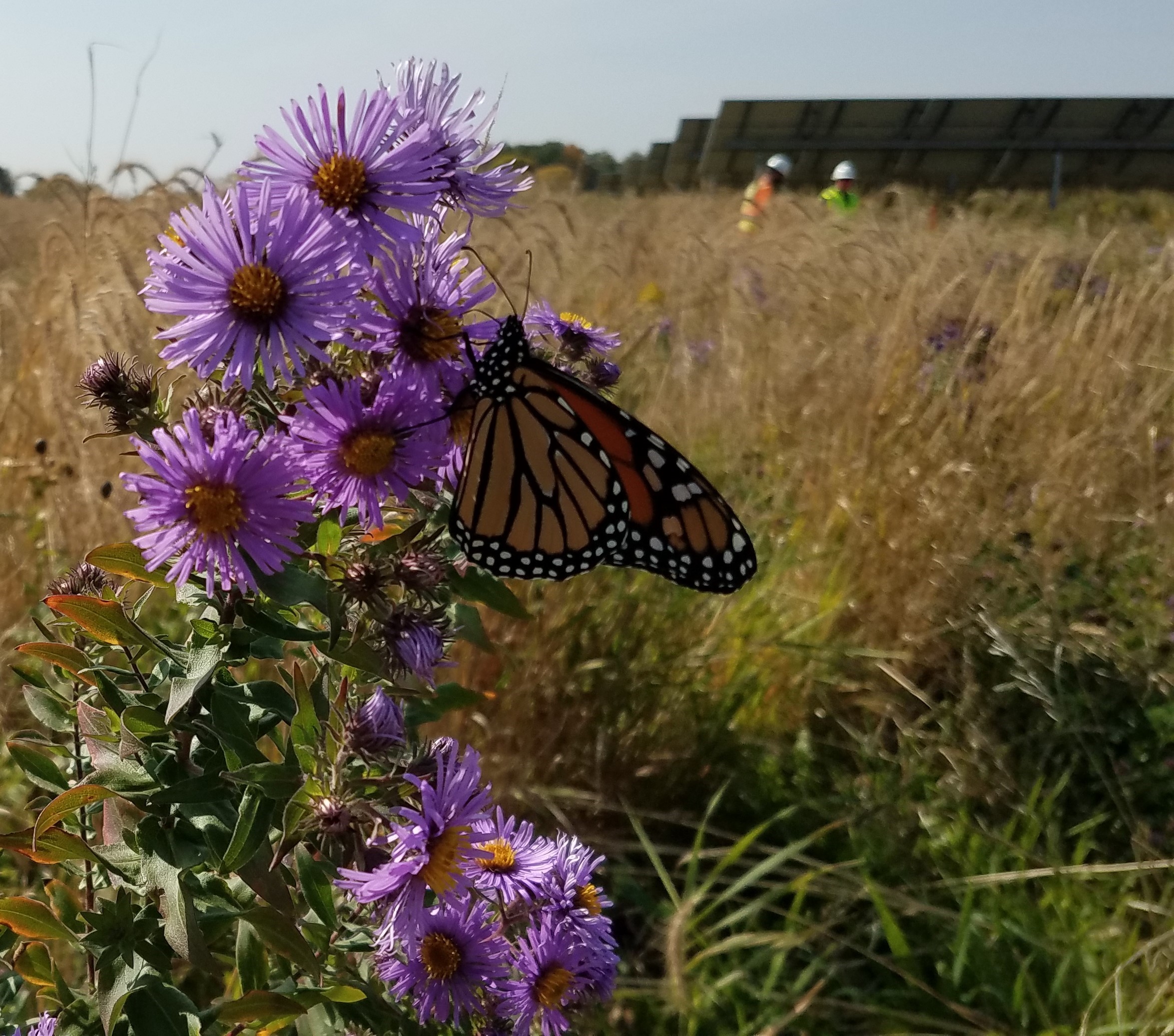
- BWSR recently updated its list of projects meeting the Habitat Friendly Solar Standard, which now includes over 50 projects on over 1,200 acres.
- The Department of Commerce, DNR, PUC and BWSR staff collaborated on new guidance for developing vegetation plans for solar projects.
- The National Renewable Energy Lab (NREL) is publishing research on the habitat, hydrology, panel cooling and other benefits of habitat solar projects. The study includes nine sites in Minnesota, involves testing of state habitat solar seed mixes, and will provide an important scientific foundation for the program.
- As a next step, staff plan to further engage with local governments about their solar efforts and provide additional training to SWCDs that are getting involved in reviewing and inspecting solar projects.
Lawns to Legumes Program
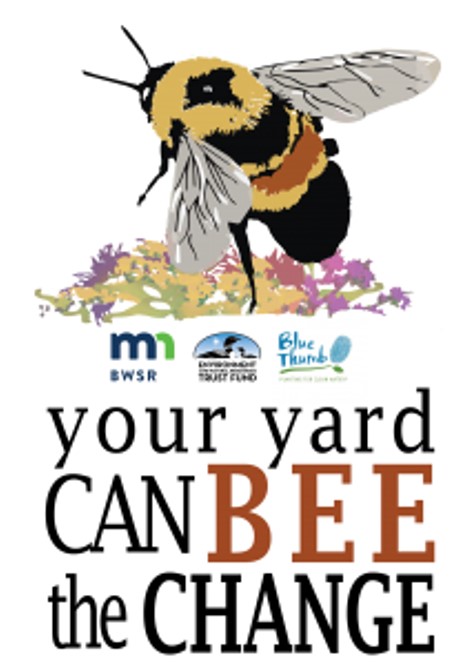
The Lawns to Legumes Pilot Program is focused on establishing residential pollinator habitat to protect at-risk pollinators. The program, which started in June 2019, has three components: 1) the establishment of “Demonstration Neighborhoods”; 2) “Individual Support” involving cost-share, coaching and workshops; and 3) a “Public Education Campaign.” The following are some key updates about each of these components:
1) Demonstration Neighborhoods – 12 Demonstration Neighborhood projects focused on communities across the state were funded in January 2020 through competitive grants and will continue through 2022. BWSR is coordinating this part of the program and ensuring that the projects are on track. With a focus on equity, the program aims to provide high quality pollinator habitat to benefit the Rusty Patched bumblebee and other at-risk pollinators.
2) Individual Landowner Support – This part of the program is being coordinated by the Blue Thumb Partnership; it includes native plant/pollinator lawn funding, coaching and workshops. The goals of this component are to establish successful projects that will provide high value to at-risk pollinators while increasing neighborhood support for the establishment of pollinator habitat. We closed the funding period in September 2020. More than 7,500 people have applied for individual support grants, with 800 -1,200 grants ultimately funded.
3) Public Education Campaign - This aspect of the program has been coordinated by BWSR, the Blue Thumb Partnership, the Minneapolis College of Art and Design and other conservation and education partners. It is focused on providing impactful outreach to increase momentum for the adoption of residential pollinator habitat and alternative groundcovers across Minnesota. This component encourages and assists landowners who want to conduct projects on their own through outreach, technical information, and guidance (involving over 5,000 landowners).
The program’s website contains a variety of planting resources including the Lawns to Legumes Residential Planting for Pollinators Habitat Guide, several plant design templates and more. In 2020, the Planting for Pollinators Habitat Guide won a MN Association of Landscape Architecture Merit award. In 2020, BWSR applied for and received additional FY21 LCCMR funding (L2L Phase 2) which would expand the program to community spaces. This additional funding will allow BWSR to expand grant application opportunities and build on the momentum of this successful pilot program. In 2021, the program won three awards: Northern Lights Award of Merit for the L2L Public Outreach Campaign, Environmental Initiative Award for Large Scale Sustainability Impacts and U of MN Humphrey School of Public Affairs Government Innovation award.
Pollinator and Beneficial Insect Program
A new program focused on benefitting pollinators and beneficial Insects on conservation lands and natural areas was funded through LCCMR this legislative session. This program will play an important role in the strategic placement of high-quality habitat. Funding will be available this fall as a request for proposal to Soil and Water Conservation Districts to work with landowners.
Other Pollinator Updates
-
As part of the Governor’s Pollinator Executive Order, BWSR’s Pollinator Initiative, the Lawns to Legumes program and other efforts including the BWSR Pollinator Toolbox continue to evolve with new information.
-
The Interagency Pollinator Protection Team, managed by the Environmental Quality Board, writes an annual Minnesota State Agency Pollinator Report, which is focused on meeting state pollinator goals.
-
A new fact sheet in collaboration with Xerces Society has also been developed on Protecting Conservation Lands from Pesticides.
-
BWSR has continued to discuss options for conducting additional pollinator habitat mapping in Minnesota, continuing efforts that were started in Washington County and Minneapolis.
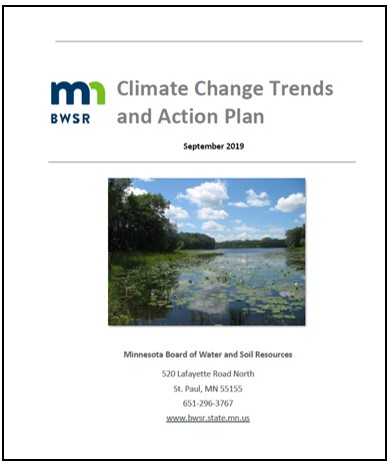 Climate Adaptation/Mitigation & Carbon Sequestration
Climate Adaptation/Mitigation & Carbon Sequestration
-
BWSR updated its Climate Change Trends and Action Plan in 2019. This plan includes updated numbers on carbon sequestration and greenhouse gas emissions reductions for conservation projects since 1987 as well as climate related action steps for the agency. This plan will undergo additional updates in 2021.
-
BWSR’s Climate Resiliency Toolbox is another key resource BWSR is using to increase awareness about practices that can be used to address extreme precipitation and accomplish climate mitigation.
-
As part of the Governor’s Climate Change Executive Order and development of a Climate Sub-Cabinet, agencies are collaborating on the development of a Climate Action Framework for Minnesota, expected to be completed this fall.
-
The State Climatology Office has a tool that helps assess Minnesota Climate Trends by major watershed
Featured Plants
BWSR plans to continue writing featured plant articles. If you are aware of partners who are interested in signing up to receive the articles, please direct them to this link. BWSR also welcomes guest authors for articles and photos. Contact Tara.perriello@state.mn.us to learn more.
What’s Working for Conservation Information
New information has been added to BWSR’s “What’s Working” webpage to document successful conservation practices. This latest round focused on additional landscape management practices as well as collecting the knowledge and wisdom from professionals with many decades of experience. We would like to continue adding new information on all topics, so please send new information to Dan Shaw at dan.shaw@state.mn.us.
Soil Health
The use of cover crops, no-till and strip till practices, and incorporating perennial vegetation in agricultural landscapes have been a focus for conservation efforts since they promote good soil structure, high organic content and microorganism populations that improve soil health and sustain productive ecological and agricultural functions. Deeper rooted vegetation across a wide range of landscapes increases evapotranspiration during the spring and fall seasons, reduces runoff and erosion, and helps recycle nutrients. Deeper rooted plants also increase organic matter in the soil profile over time, which increases infiltration and water holding capacity for plant needs, reducing runoff, erosion and nutrient transport. The Minnesota Office for Soil Health provides technical resources and assistance to local partners. For more information, see BWSR’s soil health webpage.
The following information is also found on BWSR’s What’s Working webpage and was provided by Dr. Anna Cates from the Minnesota Office for Soil Health.
To learn more about different cover crops, you can start by exploring online decision tools from the NRCS, University of Minnesota, and the Midwest Cover Crops Council (MCCC). The MCCC’s Cover Crop Recipes describe low-risk approaches for beginning cover croppers. UMN and the NRCS also have partial budget tools that can help you consider various costs and benefits. A great way to learn more about managing cover crops is to talk with farmers during a field day, or one-on-one about their own experiences with cover crops. You can find mentors on farmmaps.umn.edu or with the Minnesota Soil Health Coalition.
Cover crop resources
- UMN Extension cover crops
- Minnesota cover crop research
- UMN cover crops economics spreadsheet
- NRCS Cover Crops Economics Tool
- Midwest Cover Crops Council:
Forest Stewardship
Landscape stewardship plans (LSPs) like the MPCA Watershed Restoration and Protection Strategies (WRAPs) and the MDH Groundwater
Restoration and Protection Strategies (GRAPs) provide important information and relevant context from state water and forest resource programs to inform comprehensive local water management (1W1Ps) processes. Members of the 1W1P committees are encouraged to consider the recommendations in this document for incorporation into their plans. Through the integration of landscape stewardship plans and 1W1Ps, conservation professionals and landowners are working together to address the following national priorities from the USDA Forest Service:
- Conserve Working Forest Lands.
- Protect Forests from Harm.
- Enhance Public Benefits from Trees and Forests.
- Recognizing the critical linkages between forests and water quality, the Minnesota Department of Natural Resources (DNR) and the Minnesota Board of Water and Soil Resources (BWSR), together with local partners and private landowners, have teamed up to develop watershed-based landscape stewardship plans across the forested regions of the state. Five landscape stewardship plans have completed as of 2021 for the Leech Lake River Watershed, Mississippi Headwaters Watershed, Pine River Watershed, Redeye River Watershed, and the Rum River Watershed and are available on BWSR’s Forest Land webpage.
Restoration Evaluation Program
The state’s Legacy Fund Restoration Evaluation Program continues to visit restorations throughout the state to get a better understanding of what practices are most successful and how to improve future projects. Recommendations from these assessments are available in the legacy fund restoration evaluation program report. You can also learn more about these restorations in the improving restorations webinar series.
Invasive Species
Conservation partnerships around the state such as Cooperative Weed Management Areas (CWMAs) and Cooperative Invasive Species Management Areas (CISMAs) as well as county weed inspectors and local government conservation staff are on the front lines managing invasive species in the state. A new Tactical Invasive Plant Management Plan led by the Minnesota Department of Agriculture (MDA) has been developed to help guide decision making for invasive species management by showing areas of potential spread for many species, plus key life cycle and management information. The diagram below demonstrates the roles of different invasive species partners in Minnesota.
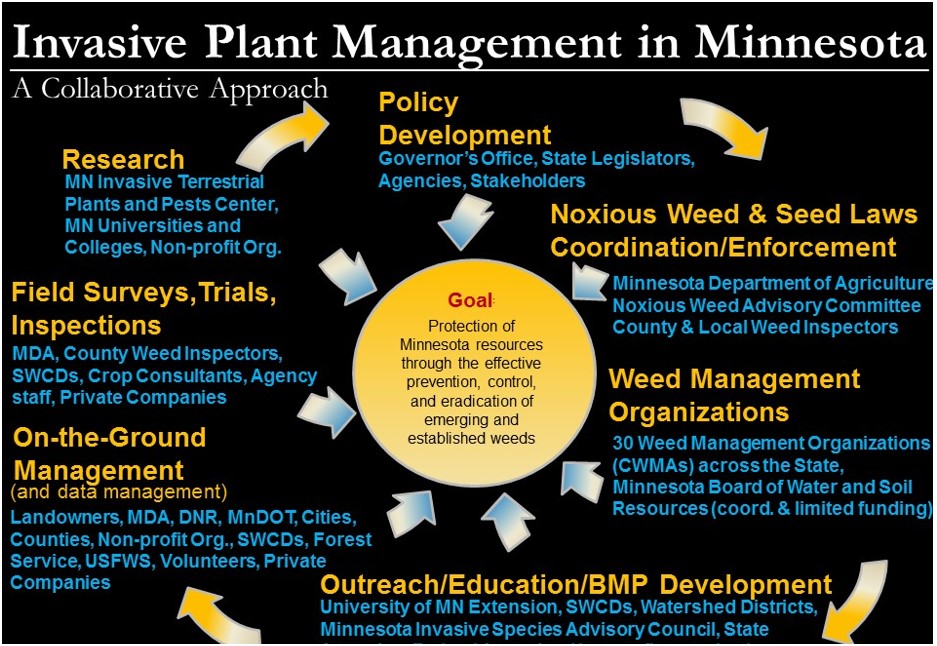
Cooperative Weed Management Areas and Invasive Species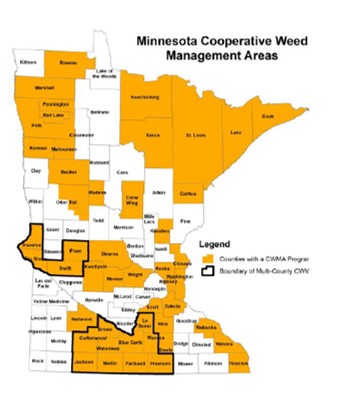
The Cooperative Weed Management Area Grant Program plays an important role in aiding the establishment of new weed management organizations across Minnesota, covering over forty counties. The program’s fact sheet includes a map that shows the distribution of CWMAs across Minnesota.
- New technical information has been developed on guiding principles for maintaining diversity while treating invasive species along roadsides.
- Agencies continue to focus on preventing the spread of Palmer Amaranth in Minnesota. BWSR’s Native Vegetation Establishment and Enhancement Guidelines include a section on the prevention of the species in seed and MDA is continuing to conduct field inspections.
- A new Tactical Invasive Species Plan was developed for Minnesota. This plan offers guidance to decision-makers for prioritizing invasive plant management activities.
- New funding has been appropriated for this program in and will be released through a request for proposal in the fall of 2021.
American Highbush Cranberry and its lookalike, European Guelder-rose
American highbush cranberry is native to Minnesota and has been widely sold and promoted, but it turns out that many plants may have been the non-native lookalike European guelder-rose. This mix up is likely still happening. Soil and Water Conservation Districts and conservation practitioners should be aware of this issue and avoid using or selling the non-native European guelder-rose.
American Highbush Cranberry (Viburnum opulus var. americanum also known as Viburnum trilobum) is a common shrub found in most counties in Minnesota that grows in moist soils in part shade or sun, along forest edges, clearings, wetlands and shorelines. It produces an edible, tart fruit similar to true cranberries. It is commonly recommended for conservation projects and is sold by many Soil and Water Conservation Districts in their annual tree and shrub sales.
Guelder-rose (Viburnum opulus var. opulus, also known as European highbush cranberry and snowball bush) is non-native shrub introduced from Europe. Guelder-rose is nearly identical to the native American highbush cranberry, and the non-native shrub is often sold labeled as the native shrub. Guelder-rose has escaped cultivation and has spread in Minnesota. According to Welby Smith (MN DNR) in his book “Trees and Shrubs of Minnesota” “nearly all the ‘high-bush cranberry’ sold by nurseries in Minnesota today are in fact the European V. opulus.” Smith also notes that the non-native shrub “seems to compete more aggressively than the native highbush cranberry” and “around the Twin Cities and southward, the European species is now more common that the native species” and there are concerns that the two species may hybridize.
ID Tips:
-
Distinguish by the size and shape of the petiolar glands found at the tip of the leaf stalk (magnification is helpful).
-
The glands of the native highbush cranberry are typically taller than wide, round to oval, and are flat or rounded (convex) at the tip, lacking a distinct rim.
-
Guelder-rose’s petiolar glands are typically shorter that wide, oval-elliptic, and are bowl or cup-shaped (concave) with a distinct rim.
-
-
The drupes, or fruit of the native highbush cranberry are tart and taste like cranberries, while the guelder-rose’s fruit are sour, bitter, and reportedly “taste like feet.”
More information: “Trees and Shrubs of Minnesota” by Welby Smith, Minnesota Wildflowers website.
Photos courtesy Minnesota Wildflowers. (Photos L-R: native highbush cranberry, Glands of native highbush cranberry, Glands of non-native guelder-rose)
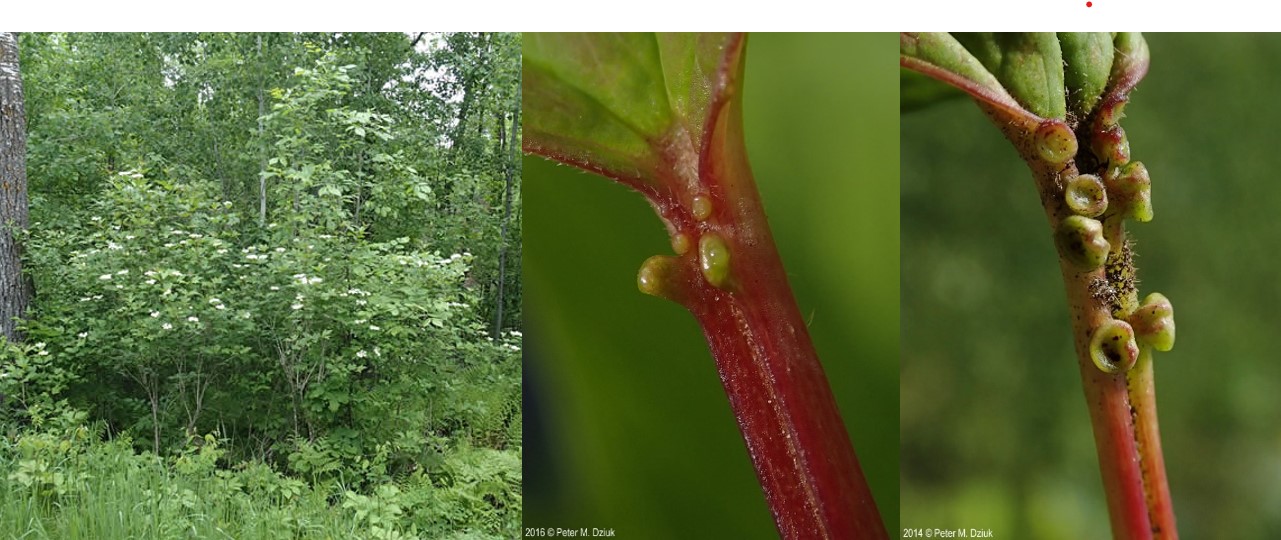
(Petiolar glands- Native highbush cranberry, Petiolar glands – non-native guilder-rose, Petiolar glands – non-native V. opulus)
Jumping Worms Update
There has been significant concern recently about jumping worms and their potential impact to plant communities and residential landscapes. The DNR has a website about the species with detailed information.
Jumping worms can dramatically change soils, giving it a unique texture similar to coffee grounds. Jumping worms feast on mulch and strip vital nutrients from topsoil. This kills plants and increases erosion. Homeowners may see garden plants killed and may have difficulty growing plants.
Jumping worms can cause environmental harm where they are established. Studies have found nonnative earthworms dramatically change forest soils by eating the leaf litter layer and impacting soil chemistry, soil organisms and plant communities. Jumping worms have been shown to have similar effects. When the soil changes, the forest can’t support the same plant and animal species it did before.
-
- Be on the lookout for jumping worms in soil, potted landscape plants, mulch or compost. You might see soil that looks like coffee grounds or notice unusually jumpy worms in your mulch. Don’t move any material that might be harboring jumping worms and report any suspected jumping worms to the DNR.
- Clean soil off your gardening gear (tools, gloves, shoes, carts, etc.) before taking it to another yard.
- If you participate in garden club plant sales or informal plant exchanges, follow these recommendations:
- Determine that the plants do not come from an area known to have jumping worms. Additionally, determine that there is no reason, like soil that looks like coffee grounds, to suspect there are jumping worms at the site that produced the plants. Remove soil from all plants before transporting them as bare root plants or potting into sterile potting soil. This helps to remove earthworm cocoons (egg cases) and weed seeds. View the University of Minnesota Extension full list of guidance on plant sale best practices (link is external) related to jumping worms.
Ecological Training (from DNR Staff)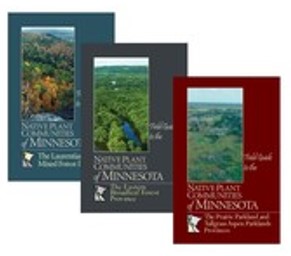
The Minnesota Department of Natural Resources will offer Ecological and Native Plant Community trainings this year.
This training group has met regularly since fall 2020 and for a variety of reasons, DNR decided to postpone in-person trainings in 2021.
Stay tuned for more information about upcoming trainings, including Module 1: “Introduction to Native Plant Communities of MN,” which is currently being developed. More information can be found here.
Prairie Pod
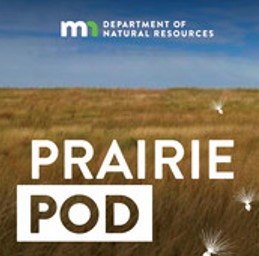 The Prairie Pod is launching its 4th season starting July 6
The Prairie Pod is launching its 4th season starting July 6
The Prairie Reconstruction Initiative is hosting a virtual field day on October 13 and 14: "Overcoming challenges of Pollinator Friendly reconstructions." Expect an email with more details as we get closer!
Plant lists for select public lands are available so you can “self-train” and brush up on identification skills (Scientific and Natural Areas offer these on the web—check them out and get outside)!
TRAINING: For ecology-focused training opportunities, visit our Online Learning Portal.

